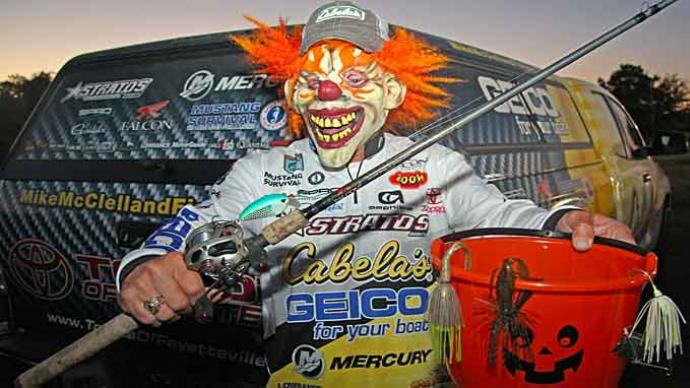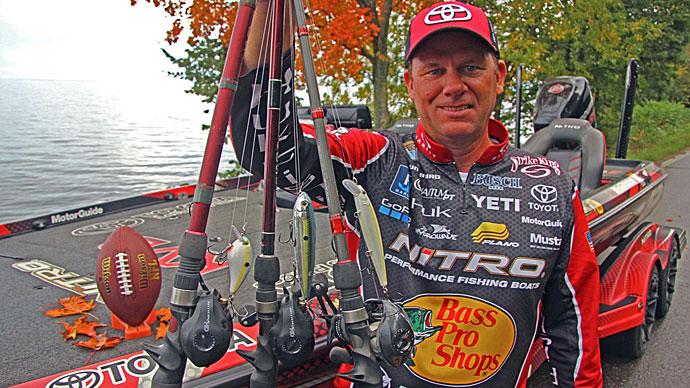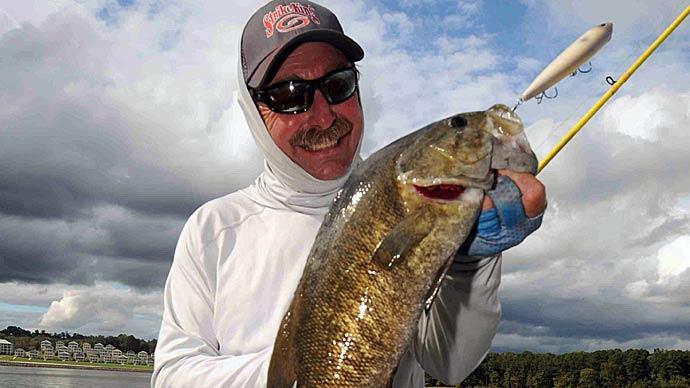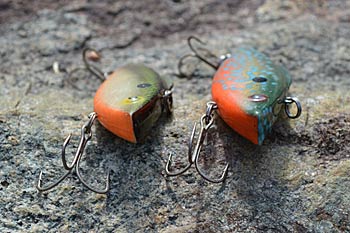
If you’re a bass angler living north of the Mason-Dixon line, you can see the end once the calendar flips to October. While fewer boats on the water are welcome, the days are getting shorter, and the weather is colder. Winter is on its way. It won’t be much longer, and your favorite spots will be locked under ice, halting your open-water fishing.
But if you act quickly, there’s still time for great fishing on northern natural lakes, where schools of 3- to 4-pound largemouth and smallmouth make up for fewer big ones. Here are five lures to use — and where to use them — during the final weeks of the open-water season.
Lipless crankbaits
Less daylight and colder water aren’t prime conditions for growing aquatic vegetation. But if you look slightly deeper than you’ve been fishing all summer, you’ll usually find some beds of still-green plants. It often grows under the ice, especially when snow cover is minimal, allowing the sun to shine through the ice.
It attracts bass regardless of where or when you find submerged aquatic vegetation. And on those last warm days of fall, when bass suspend throughout a bed to absorb a little of the sun’s warmth, there’s no better lure to fish than a lipless crankbait.
This isn’t turn-and-burn fishing. Instead, work your lipless crankbait like a jig. You want it to fall into the top of the vegetation and get hung, attracting nearby bass. Then rip it out, drawing reaction strikes from them.
Generate that action by starting with your rod straight in front of you, then raising the tip straight at a fast pace to make your crankbait wobble. You’ll need to pop it free when it hangs in the grass, and the key to pulling that off is wrapped in your line.
Braided line lacks stretch, which allows you to clear vegetation from your lure with a quick snap of your wrists. Choose one between 15- and 20-pound test. Its thin diameter will help your lure swim freely and sink faster. Spool it on a high-speed reel — 7:1 or greater gear ratio — which will quickly suck up slack line, enabling solid hook sets on bass that eat your lure as it falls after a rip.
Finish your outfit with a medium-action rod that sports a heavy power. It’s a little beefier than the typical crankbait rod, which will help your rips but still soft enough to keep bass on your treble hooks.
Stick with lipless crankbaits that weigh 1/2 ounce or less. They have enough weight to create an attractive fall but not too much to mire you deep in the grass. You’ll be fishing clear water — which allows enough light for aquatic vegetation to grow — so stick to natural colors that resemble shiners or yellow perch. Swap the stock trebles for ones a size larger. Their extra gap will grab bass that only slap at your lure in cold water, meaning an extra fish or two by day’s end.
Image
Spinnerbaits with small willow-leaf blades are easier to fish in deep water. And a thin diameter wire frame will help those blades produce more vibrations. Photo by Pete M. Anderson Spinnerbaits
As fall progresses and the water temperature drops, bass become less interested in chasing a lipless crankbait. But that doesn’t mean giving up on moving lures. A spinnerbait will still catch them.
Spinnerbaits work in the same places where you fished a lipless crankbait. But instead of casting into the beds of submerged aquatic vegetation, aim for points and pockets along their edges or any large holes within. Spots where you find rock and grass mixed are best.
Start your retrieve after your spinnerbait sinks to the bottom. Move it fast enough to stay off the bottom and spin its blades. If it bumps bottom now and again, all the better. Keeping it there starts with your rod. Use one 7 feet or longer. It will cast farther, giving your lure more time to make its way along the bottom. Slow reels — those with a 5:1 or 6:1 gear ratio — will keep you from pulling your spinnerbait too fast, causing it to rise. And like with lipless crankbaits, choose a braided line so you can snap vegetation from your lure.
Choose a spinnerbait with a baitfish-colored skirt and two small willow blades, such as sizes 3.5 and 4, a mix of silver and gold. They create plenty of flash without much lift and, on a spinnerbait built with thin wire, have plenty of vibration. And upsize its weight — at least 1/2 ounce. Adding a soft plastic trailer is up to you. While the added action can entice bass to strike, they add bulk, making a spinnerbait sink slower.
Image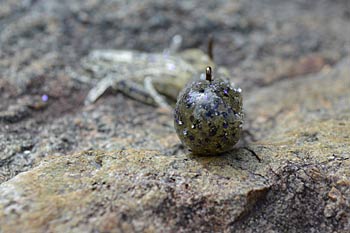
Pay attention to the line tie on the lead head that you stuff inside your tubes. Those at a 90-degree angle to the hook shank give your lure more action. Photo by Pete M. Anderson Tubes
Cooling water concentrates baitfish into schools as they seek the last spots to offer their preferred water temperature. You’ll find them outside of a river’s main channel or around deep points or sunken islands in lakes. Regardless of where, bass can’t ignore them. And one of the best lures to throw at them is a tube.
These bass — most often smallmouth — can school at various depths, even when open water is at its coldest point. Tubes can be fished at any depth by simply adjusting your retrieve. Short rhythmic twitches, for example, will make it swim. And dragging one along the bottom behind a drifting boat will catch the deepest bass.
The key to this versatility is the weight of the lead head. Use heavier ones — at least 3/8 ounce — when fishing the bottom and lighter ones — 1/16 ounce or 1/8 ounce — when swimming a tube. You’ll get better action by using heads with a 90-degree line tie. That will help pop the tails upward, whether you are moving the lure with your rod or stumbling over rocks along the bottom.
Stick to a few colors. Baitfish and perch imitations, such as clear with silver flake, smoke, or watermelon with red and gold flakes, work best higher in the water column. When fishing on the bottom, go with pumpkinseed, green pumpkin, or straight black.
Spinning rods work best. Use braided line, adding a 4- to 5-foot leader of 6- or 8-pound test fluorocarbon line. That way, you can change or retie lures several times without replacing the entire leader.
Image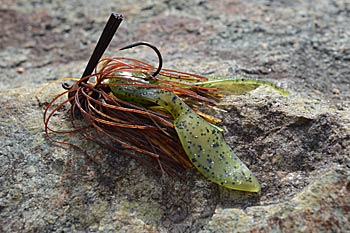
Use jig trailers that add bulk without much action in cold water. That will help keep your jig on the bottom. Photo by Pete M. Anderson Jigs
A jig and soft-plastic trailer is a time-tested choice for catching bass from cold water. It has a subtle action that closely mimics crawfish and bluegill. It can be fished as slow and as deep as needed. Often in the late fall, that can be only a few feet. Fishing shallower as the water temperature drops may be counter-intuitive, but it has the potential to pay off big when you’re targeting largemouth.
Inside edges of aquatic vegetation beds are often overlooked, even in the warmest weather. But within their few feet of depth, you can find plenty of largemouth, including big ones. And they’ll use that edge for ambush and cover as long as the water level and temperature allow them.
In the fall, the best inside edges are close to a lake’s main body, where water temperatures are slower to fall, and aquatic vegetation stays green longer. Search out rocky banks that fall at an angle into the vegetation. That creates a sharp edge. While anywhere along the edge can produce bass, key on larger rocks, points, docks, or any other cover that interrupts it.
Cast or pitch your jig close to shore, and let it hit bottom. Then pull it toward the vegetation, so it slides and falls into its base.
You can use everyone’s favorite size of jig — 3/8 ounce. But as the inside edge starts deeper, such as on steeper banks, use a 1/2-ounce model. It sinks faster and stays on the bottom better in blowing winds and crashing waves.
Stick to jigs in browns, green pumpkins, and blacks that match crawfish. Trailers in similar colors that add bulk without much action will help your jig reach the bottom and stay there. Tie them on 20-pound test low stretch monofilament that’s spooled on a high-speed reel attached to a heavy power 7-foot or longer rod. That line holds less water than braid, reducing icing problems. Its larger diameter is easier to grab with numb fingers. And a clear or green color will be invisible to bass against the grass, even in the clearest water.
Image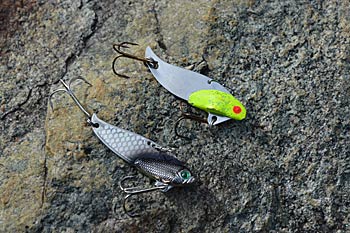
The less you move your blade bait, the more bites you’ll get. Once on the bottom, pull it forward with your rod until you feel it start to vibrate. Then stop and let it fall back to the bottom. Photo by Pete M. Anderson Blade bait
Blade baits are the last lure you’ll throw before ice up. They create vibrations like a lipless crankbait but are easier to fish along the bottom. They work exceptionally well in rivers, where largemouth and smallmouth school in deep holes in backwaters.
Work your blade bait with your rod. Once it hits bottom, lift the rod just enough to feel your lure work for a few seconds before letting it settle back on the bottom and remain motionless. Bass will grab them off the bottom. Less can be a lot more in cold water.
Start with a 1/4- or 3/8-ounce blade bait, going heavier if current or wind makes feeling it difficult. You can’t go wrong with a metallic color — silver on sunny days and gold on cloudy ones — which gives off lots of flash with small movements. Experiment with brightly painted ones — white, fire tiger, or chartreuse — in stained water.
Casting or spinning rods will handle blade baits. But choose a shorter one, less than 7 feet. It will keep you from moving too much line when you work a blade bait, keeping it closer to the bottom. Slower reels — those with 5:1 or 6:1 gear ratio — will help, too.
Braided line’s sensitivity makes feeling light bites easier, but tie in a short 8- to 10-inch piece of 10- or 12-pound test fluorocarbon leader. It’s stiffer than braid, helping reduce fouling of your lure by staying in front of it. With its wild movements, blade baits often flop over on themselves, allowing either or both of their dangling treble hooks to catch the limper braided line, fouling a retrieve.
Don’t tie directly to your blade bait; use a quality locking snap instead. It will give your blade bait more freedom to move and remove any worries of the metal lure slicing through your fluorocarbon.


